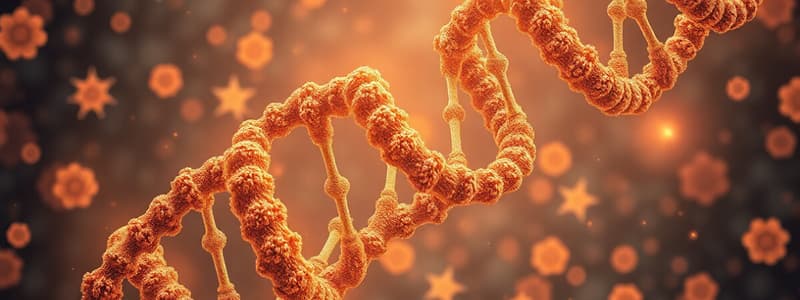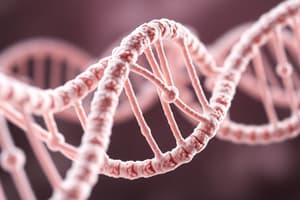Podcast
Questions and Answers
What are the three parts that make up a nucleotide?
What are the three parts that make up a nucleotide?
- Deoxyribose sugar, phosphate group, amino acid
- Ribose sugar, phosphate group, nitrogen base
- Deoxyribose sugar, phosphate group, nitrogen base (correct)
- Deoxyribose sugar, phospholipid, nitrogen base
Which statement about complementary base pairing is true?
Which statement about complementary base pairing is true?
- G pairs with U which is found in DNA.
- A pairs with T through two hydrogen bonds. (correct)
- C pairs with T through three hydrogen bonds.
- A pairs with G through two hydrogen bonds.
How are the two strands of DNA organized?
How are the two strands of DNA organized?
- They twist in the same direction throughout the entire molecule.
- They run parallel to each other.
- They are circular and do not have ends.
- They run antiparallel, with a 5' end on one strand opposite a 3' end. (correct)
Which of the following nucleotides is not found in DNA?
Which of the following nucleotides is not found in DNA?
What aspect characterizes the structure of prokaryotic DNA?
What aspect characterizes the structure of prokaryotic DNA?
What enzyme is responsible for controlling DNA supercoiling?
What enzyme is responsible for controlling DNA supercoiling?
Which statement regarding the majority of DNA in an organism's genome is true?
Which statement regarding the majority of DNA in an organism's genome is true?
What does the term 'genome' refer to?
What does the term 'genome' refer to?
Flashcards are hidden until you start studying
Study Notes
DNA Structure & Organization
- Deoxyribonucleic Acid (DNA) is made of repeating subunits called nucleotides.
- Nucleotides are composed of three parts:
- Deoxyribose sugar (5 C)
- Phosphate group
- Nitrogen base
- Nucleotide structure:
- Phosphate group is attached to carbon 5 (5’) of the deoxyribose sugar.
- Nitrogen base is attached to carbon 1 (1’) of the deoxyribose sugar.
- The next nucleotide attaches to carbon 3 (3’) of the deoxyribose sugar.
- Nitrogen bases:
- Two types of nitrogen bases:
- Pyrimidines: Single rings
- Uracil (U, present only in RNA)
- Thymine (T, present only in DNA)
- Cytosine (C)
- Purines: Two rings
- Adenine (A)
- Guanine (G)
- Pyrimidines: Single rings
- Two types of nitrogen bases:
- Complementary base pairing:
- Guanine (G) pairs with Cytosine (C) via three hydrogen bonds.
- Adenine (A) pairs with Thymine (T) via two hydrogen bonds.
- Both pairs have the same diameter.
- Double helix:
- DNA is composed of two strands.
- The phosphate and sugar molecules form the backbone on the outside.
- Strands run antiparallel, meaning the 5' end of one strand is across from the 3' end of the other strand.
- The direction of the helix is clockwise.
- One turn of the helix contains 10 nucleotides.
- The nucleotides are spaced 0.34 nm apart.
- Complementary base pairing:
- The two strands of DNA are complementary due to the hydrogen bonds formed between the nitrogenous bases.
- Each strand has a 5′ end and a 3′ end.
- Organization of DNA
- Genome: the total genetic material of an organism.
- Gene: a functional unit of DNA.
- Most of the DNA in an organism's genome is non-coding and does not contain genes.
Prokaryotes
- Prokaryotes have a circular, double-stranded DNA molecule.
- DNA is not contained within a nucleus and instead is packed in a region called the nucleoid.
- DNA is tightly packed by coiling, compacting, and supercoiling.
DNA supercoiling
- Supercoiling is the formation of additional coils in the DNA structure due to twisting forces.
- Supercoiling is controlled by the enzymes topoisomerase I and topoisomerase II.
Studying That Suits You
Use AI to generate personalized quizzes and flashcards to suit your learning preferences.




